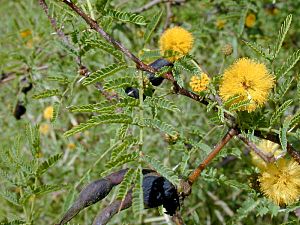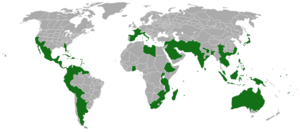Sweet acacia facts for kids
Quick facts for kids Sweet acacia |
|
|---|---|
 |
|
| Conservation status | |
| Scientific classification | |
| Genus: |
Vachellia
|
| Species: |
farnesiana
|
| Varieties (all currently disputed) | |
|
|
 |
|
| Synonyms | |
|
|
The sweet acacia (Vachellia farnesiana) is a type of shrub or small tree. It is also known as Acacia farnesiana or Mimosa farnesiana. This plant belongs to the legume family, called Fabaceae. This family includes plants like peas and beans.
The sweet acacia can be deciduous, meaning it loses its leaves in some areas. But in most places, it stays evergreen and keeps its leaves all year. It can grow to be about 4.5 to 9 meters (15 to 30 feet) tall and often has many trunks. Each leaf has a pair of sharp thorns at its base on the branch. The flowers of the sweet acacia are very fragrant and are used to make perfumes.
Contents
What's in a Name?
Why is it Called Farnesiana?
The name farnesiana comes from Odoardo Farnese, an Italian cardinal who lived from 1573 to 1626. His family, the House of Farnese, had some of the first private botanical gardens in Rome. These gardens were famous in the 16th and 17th centuries.
This acacia plant was first studied from plants grown in these gardens. The seeds were brought to Italy from Santo Domingo, which is now the Dominican Republic. Scientists later found a chemical in the flower extract of this plant. They named this chemical farnesol after the Farnese family. Farnesol is important because it helps plants and animals create other important substances.
Other Common Names
In Mexico and Texas, the plant is called huisache. This name comes from the Nahuatl language and means "many thorns."
In Australia, it is known as needle bush because of the many thorns that cover its branches.
How Scientists Classify This Plant
A Look at its History
The sweet acacia was first described by Europeans in 1625. A scientist named Tobias Aldini saw plants growing in the Farnese Gardens in Rome. These plants grew from seeds collected in Santo Domingo in 1611. Aldini even drew a picture of the plant.
Later, in 1753, Carl Linnaeus, a famous botanist, gave the plant the name Mimosa farnesiana. Then, in 1806, Carl Ludwig Willdenow moved it to the genus Acacia.
Because this plant grows in so many different places, it has been given many different scientific names over time. This has sometimes made its classification confusing, especially in the United States.
For example, in 1834, scientists tried to split the large Acacia group into smaller ones, moving some Indian Acacia species to a new group called Vachellia. This idea was not widely used at first. However, in recent years, scientists have moved Acacia farnesiana to the genus Vachellia.
Scientists continue to study the sweet acacia to understand its different types and how they are related.
Where Does Sweet Acacia Grow?
The sweet acacia has one of the widest distributions of all Acacia species. It is found all over the world in tropical areas.
Scientists believe it originally came from the Caribbean, Mexico, or Central America. Today, you can find it in most of the Americas, from the southern USA down to Chile. It also grows in Australia, Africa, southern Europe, and southern Asia.
In the Caribbean, it grows from the Bahamas and Cuba down to Trinidad. In the United States, it is thought to be native to southern Texas, New Mexico, Arizona, and California. It might also have spread naturally to other southern states.
It is still debated whether the plant spread to places like Australia and the Philippines naturally (perhaps its seeds floated across the ocean) or if humans helped it spread. However, DNA studies in 2017 suggest it likely came from Central America.
Sweet Acacia in Nature
Its Role in the Environment
Many animals interact with the sweet acacia. Deer and peccaries (a type of wild pig) enjoy eating its fruit. Various birds build their nests in its branches and use it for shelter. Insects visit its flowers to drink the sweet nectar.
If the plant is cut or damaged, it can easily grow back. It also grows well in dry, salty, or sodic soils (soils with high sodium).
When it Becomes a Problem
In some parts of Australia, the sweet acacia is considered a serious weed. It can spread quickly in pastures where cattle graze, especially near creeks. This can make it hard for farmers to move their cattle and can even damage farm machinery.
Cattle help spread the seeds because they eat the nutritious pods. The plant grows even more when pastures are overgrazed. Farmers often use special chemicals to control it. The plant has spread to many new places because of human activity. In Fiji, it is considered a serious weed and is sometimes called "Ellington's curse."
How People Use Sweet Acacia
For Perfume
The flowers of the sweet acacia are used to make a perfume called cassie. This perfume is known for its "delicious" scent and is widely used in Europe. The chemical farnesol, which is important in biology, gets its name from the scent of these flowers. In India, people also make scented ointments from cassie.
Other Uses
- Gum: The plant produces a sticky natural gum that can be collected.
- Tanning Leather: The bark of the sweet acacia contains tannin, which is used to tan leather. Tannins are also found in many other acacia barks and are sometimes used in medicine.
- Food: The seeds of the sweet acacia are safe for humans to eat.
- Animal Feed: The leaves are a good source of food for animals, with about 18% protein. Bees also like the tree, and livestock readily eat the seed pods.
- Gardening: Because it can handle dry conditions, this plant is often used in xeriscaping (landscaping that uses less water) in Texas.
- Dyes and Inks: A black color can be taken from the bark and fruit.
Traditional Medicine
In some places, the sweet acacia has been used in traditional medicine.
- In Brazil, some people used the seeds to kill rabid dogs.
- In Colombia, it was used to treat malaria.
- In the Philippines, people traditionally rub the leaves on the skin of livestock to treat skin diseases.
- In Malaysia, a mix of the plant's flowers and leaves with turmeric is used for mothers after childbirth.
Gallery
See also
 In Spanish: Vachellia farnesiana para niños
In Spanish: Vachellia farnesiana para niños









